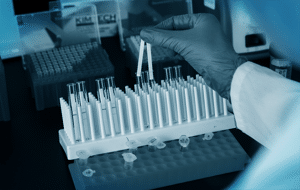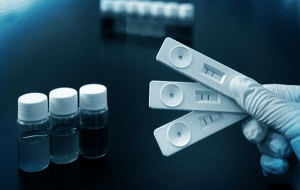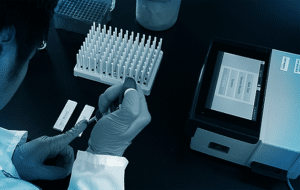The Case for User-Centric Assay Design
- By Kristin Cederquist, Ph.D.
- June 1, 2018

Origins of User-centric Assay Design
Until the advent of two-line lateral flow pregnancy tests in the late 1980s, home hCG tests were essentially miniaturized chemistry sets with complex instructions and a test tube rack. Inverness Medical’s incorporation of on-board colloidal gold immunoconjugates forever shifted the paradigm of pregnancy testing in a number of ways:
- Reduced complexity. No longer would the user be required to perform sample collection and treatment.
- Reduced time-to-result. Reaction times (not including sample preparation or manipulation time) of 30 minutes were reduced to 10-15 minutes which made the test more user-friendly.
- Integration of more robust materials. Eliminating liquid and glass components in favor of plastic and paper facilitated storage and extended shelf lifetime and decreased cost to the consumer.
- Mitigation of risk. The inclusion of a control line, reduction of steps, and simplification of instructions all compounded to give a leap forward in pregnancy-testing technology by making the results easier to interpret by an untrained user.
Since these disruptive improvements were made, there have been additional incremental advances in lateral flow tests, such as the Clearblue cross and rudimentary yes/no integrated readers. However, the canonical two-line test has so disrupted the diagnostic world that it now pervades pop culture, even earning itself a country song written by Grammy-nominated artist Eric Church.
Why was this such a revolution? After all, it was still testing for hCG, a straightforward assay even by laboratory standards and these improvements did not improve the sensitivity of the assay.
These improvements weren’t about the sensitivity; rather, they were about how the user acquired, used and read the test.
- The busy mother who was preoccupied with children and did not have 30 minutes to devote to a complex test.
- The new mother or young adult who, with nerves and shaking hands, would no longer have to worry about adding a component to the wrong tube.
- Women in complex situations, who could not risk partners or relatives uncovering test remnants.
As developers, we run the risk of preoccupying ourselves with achieving maximum sensitivity at the sacrifice of user-friendliness or cost point. Sometimes, maximum performance isn’t always the top deliverable, and sub-optimal sensitivity can easily be counterbalanced by fulfilling other end user requirements.
Though the pregnancy test is lateral flow’s most well-known achievement to date, there are other areas where the versatility of the technology shine and who’s utility is based in large part on the user experience. It is well worth it to explore some commonalities in these markets.
User-centric Assay Design for Biowarfare and Defense
In preparing for chemical or biological warfare or terrorism, first responders require tools that can be used in confusing, chaotic, and uncertain environments. Testing systems should therefore incorporate the ability to identify a broad range of possible agents in a non-ideal field setting. Lateral flow tests are optimal for such a scenario, as noted by the following attributes:
- Multiplex test strips – Commercially-available tests commonly incorporate multiple test lines to assay multiple targets of interest. Appropriate treatment can follow accurate identification.
- Barcoding – Operators can track patients by unique codes and test them in quick succession.
- Portable and robust readers – Readers take the guesswork out of diagnostics in stressful or light-limited situations, and battery operation permits their performance in the field, without electricity.
- Disposability and speed – A short run time of ≤ 15 minutes enables simultaneous screening of multiple patients and a quick sample-to-answer. Results can be read and tests discarded, with no specimens to carry back to a centralized lab.
User-centric Assay Design for Infectious Disease Testing in Low-Resource Environments
Low-resource environments can also present challenging situations for testing. Labor- and time-intensive culturing is the diagnostic gold standard for a number of infectious diseases, but for situations where this is too cumbersome, immunoassays and molecular diagnostics have stepped in to fill the gap.
Diagnostic tests in these situations must endure harsh temperatures, potential contaminants, and inexact volumes while at the same time they must produce a robust and unambiguous signal. Currently, there are a number of lateral flow immunoassays for diseases such as tuberculosis, malaria, Dengue, HIV, and Chikungunya that fulfill these criteria in the following ways:
- Point-of-care – Short run times ensure no need for return visits and allow physicians to administer a diagnosis and concomitant treatment.
- Visual readout – Colorimetric signals overcome the need for a reader, leading to simplified testing procedure.
- Rugged and non-demanding – Onboard or accompanying buffers and qualitative readout circumvent requirements for amenities such as electricity and running water.
- Cost – At under $1 USD/unit, these tests fit the price point for many developing markets.
User-centric Assay Design for Environmental and Health Monitoring
Lateral flow is amenable not only to isolated interrogation of a sample at a certain point in time, but also extended monitoring of a patient, workplace, environment, or other situation. The large volumes of tests that can produced per manufacturing run can translate into a high number of tests per lot, along with other advantages:
- Consistency – CVs of typically <10% and high reproducibility make lateral flow an ideal technology for prolonged surveillance.
- Shelf lifetime and storage – When stored under the proper conditions of desiccation, lateral flow tests have been shown to possess shelf lifetimes of multiple years. In most cases, refrigeration is not necessary.
- Little-to-no footprint – Reader technology has evolved to produce machines with increased capabilities, but lower power and space requirements. Visual qualitative tests, while less useful for quantitative monitoring, have even fewer equipment restrictions.
These are just some examples of how lateral flow, which at its core is a simple technology, can be amenable to testing diverse analytes in numerous environments. The biological measurement should be robust and as sensitive and specific as possible. However, technical performance is only part of the equation needed to have strong market uptake. Usability and customer experience are equally important. If the product cannot be distributed in a timely and cost effective manner or if the instructions for use require an advanced degree to comprehend, or if the results are confusing, the test will have little value.
The development of the two-line pregnancy test was the key step-function change which allowed lateral flow immunoassays to become the format of choice for point-of-care testing, and user-centric assay design improvements continue to be realized on an annual basis.
If you have questions about user-centric assay design, contact us. Our team of engineers, scientists and marketers will help you identify the goals, use and consumers for your test.
Latest News
March 18, 2024







